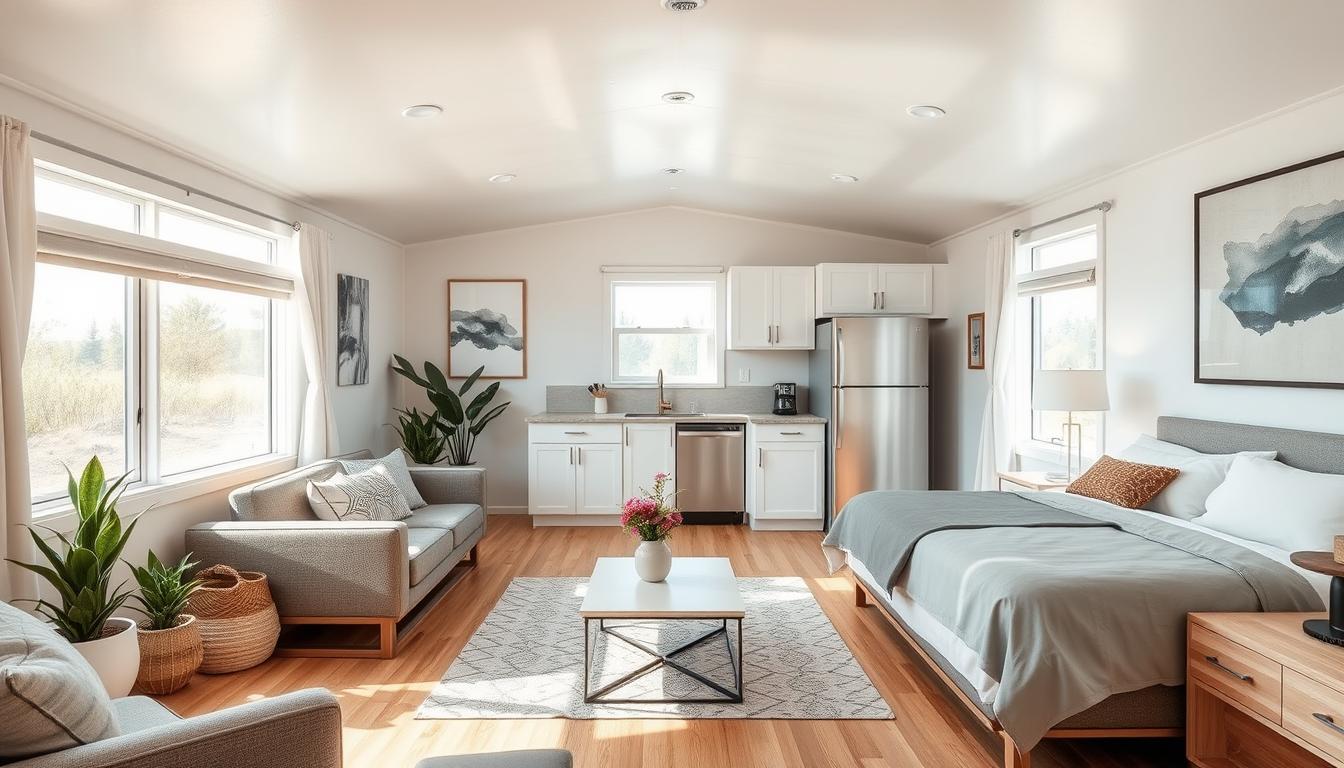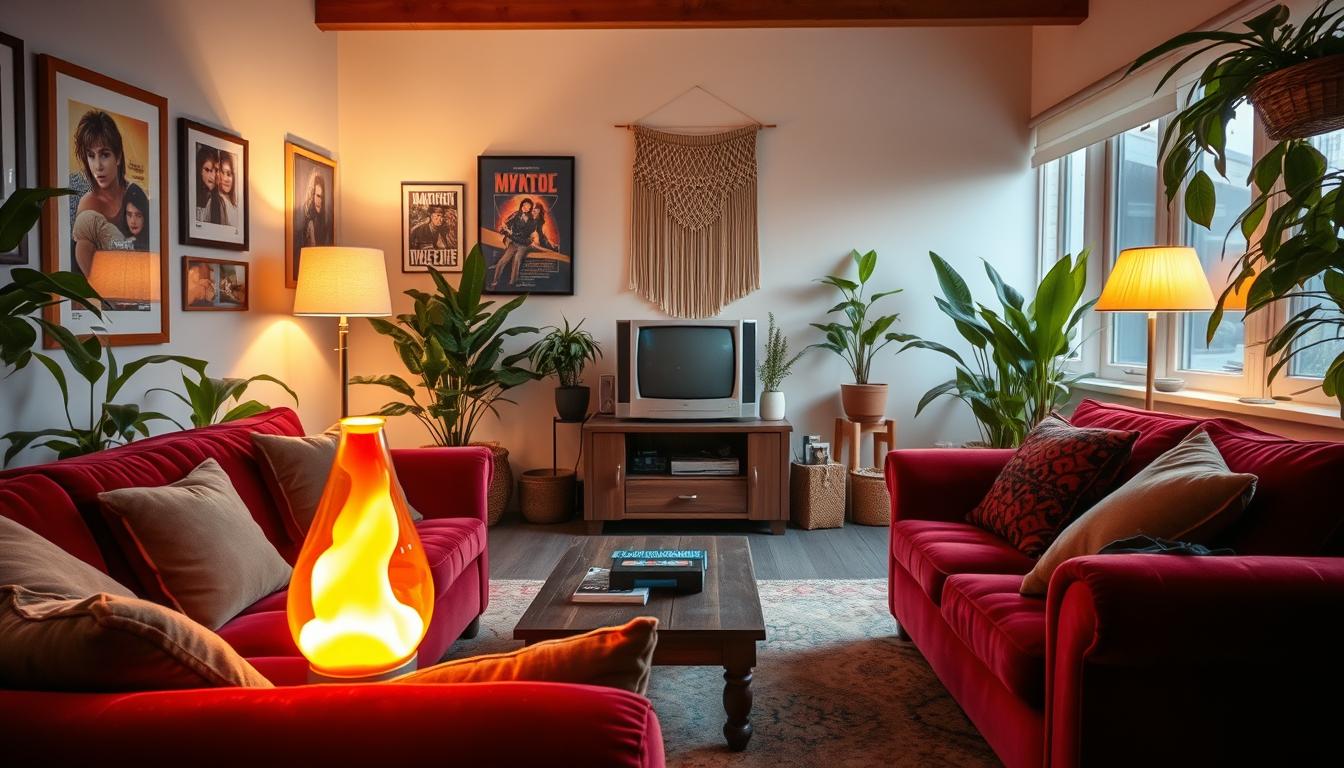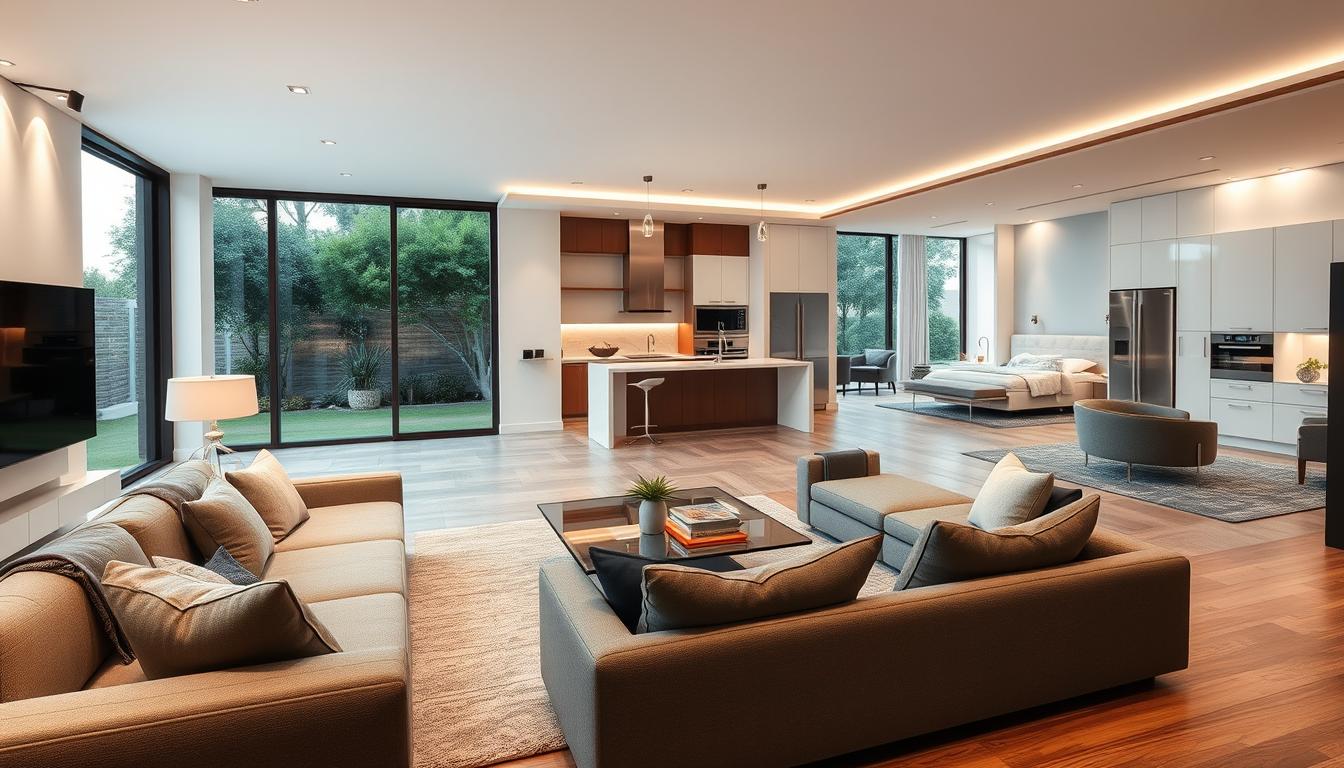Turning a 1990s mobile home interior into a modern home is a big challenge. But the end result is totally worth it. With over 7 million mobile homes in the U.S., many are looking to mobile home renovation ideas to refresh their homes.
We were among those who set out to update our old mobile home. We wanted a stylish and useful space that showed our style. With some smart renovation tips, we managed to make a big change. For more tips, see our strategies on revamping your mobile home interior.
Key Takeaways
- Assess your space to identify areas for renovation
- Choose materials and finishes that are durable and stylish
- Consider budget-friendly renovation ideas
- Update lighting and fixtures for a modern look
- Maximize storage with clever design solutions
Why We Chose to Renovate Our 1990s Mobile Home
Our 1990s mobile home needed a makeover. It had old decor and a layout that didn’t work well. We saw it as a chance to turn it into a modern, useful home.
Personal Background and Motivation
We loved our vintage mobile home but wanted to update it. We wanted to keep its charm but make it more practical. We aimed to blend the vintage mobile home decor with modern needs.
We wanted our home to show our style and be a cozy, efficient place to live.
The Benefits of Renovating
Renovating our home brought many benefits. It improved the retro mobile home design and made it more functional. We made the living area more open and inviting.
We also fixed old electrical systems and added better insulation. This made our home more comfortable and eco-friendly.
Budget Considerations
Our budget was a big part of our decision. We had to plan carefully to stay within our means. We aimed for a 90s mobile home remodel that was both affordable and effective.
We made choices that balanced our dreams with what we could afford. This helped us stay on track financially.
Assessing Our Space: A Functional Layout
The first step in our renovation was to evaluate the functional layout of our mobile home. We looked at the existing space to find areas that needed improvement.
Measuring the Living Areas
To start, we measured each room in our mobile home. We noted the dimensions and any obstacles, like plumbing fixtures or electrical outlets. This helped us understand our space and plan.
We used a tape measure to record the length, width, and height of each room. We also noted the location of doors and windows. This info was key in deciding the best layout for our furniture and decor.
Identifying Problem Areas
As we assessed our space, we found several problem areas. These included cramped corridors, outdated fixtures, and inefficient storage solutions.
- Cramped corridors that made navigation difficult
- Outdated fixtures that detracted from the overall aesthetic
- Inefficient storage solutions that cluttered the space
Creating a Vision
With our measurements and problem areas in mind, we started creating a vision for our renovated space. We thought about our lifestyle, preferences, and the latest mobile home interior design trends to guide our decisions.
Our goal was to create a functional and stylish space that met our needs and reflected our personal taste. We wanted our 1990s trailer home interior to feel modern, welcoming, and comfortable.
Key considerations included:
- Incorporating plenty of natural light
- Selecting a cohesive color palette
- Investing in multi-functional furniture
By carefully assessing our space and creating a clear vision, we were able to plan a renovation. This transformed our mobile home into a beautiful and functional living space.
Choosing a Style: From Outdated to Modern
Our journey to update our 1990s mobile home started with picking a style. We wanted to keep its nostalgic charm but also make it modern. This choice was key to our renovation, setting the project’s tone.
Exploring Popular 1990s Aesthetics
The 1990s had its own design style, with bold colors and geometric patterns. We thought about how to update these elements for today. For example, we could soften the 90s bold colors while keeping their charm.
Some key 1990s design features we considered include:
- Bold Color Schemes: The 90s were known for vibrant colors. We aimed to use these colors in a more subtle way.
- Geometric Patterns: Patterns like chevrons and paisley were popular. We thought about using them to add interest.
- Functional Design: The 90s valued practicality. We aimed to keep this while updating the look.
Selecting a Cohesive Color Palette
Choosing a color palette was crucial for our renovation. We wanted colors that would tie everything together, creating a welcoming space. We took inspiration from the 1990s but made it more contemporary.
Our process involved:
- Finding core colors that matched the 90s.
- Adjusting these colors to fit a modern, subtle look.
- Making sure the palette worked across different rooms and elements.
Incorporating Our Personal Touch
We also wanted to add our personal touches to the space. This meant choosing decorative items and furniture that fit our style and added personality to our home.
To do this, we:
- Selected decorative pieces that matched our taste.
- Added family heirlooms and personal items to the design.
- Experimented with textures and materials to add depth.
By mixing nostalgia with modernity and adding our personal touch, we created a unique and inviting space. It feels both contemporary and true to its roots.
Updating the Living Room: A Fresh Look
We were excited to update our 1990s mobile home’s living room. We knew a few changes could make a big difference.
Choosing New Flooring Options
The old flooring was worn out. We chose laminate flooring for its modern look and durability. It looked like oak hardwood, adding warmth.
Revamping Furniture Choices
Our old furniture was too big and outdated. We picked slim-profile furniture for a stylish, functional look. A new sectional sofa became the room’s centerpiece, offering plenty of seating.
Adding Decorative Elements
We added decor that showed our style. We used textiles like throw pillows and blankets in matching colors. We also hung modern artwork to make the room inviting.
Our updates gave the living room a modern, welcoming feel. The renovation made the space more functional and enjoyable for our family.
The Heart of the Home: Remodeling the Kitchen
We started our 90s mobile home remodel in the kitchen. We wanted to mix old charm with new convenience. The kitchen is key in any home, so we made it a top focus.
Replacing Outdated Appliances
First, we swapped out old appliances for new ones. The 1990s models were outdated and inefficient. We chose energy-saving appliances that matched our retro style.
Switching to energy-efficient appliances can cut energy bills by up to 30%. It’s good for the planet and saves money over time.
| Appliance | Old Model | New Model |
|---|---|---|
| Refrigerator | 1995 Energy-Star Rated | 2023 Energy-Star Rated |
| Oven/Stove | 1990s Electric Range | 2023 Induction Cooktop |
| Dishwasher | None | 2023 Energy-Saving Dishwasher |
Cabinet Refacing vs. Replacement
Choosing between refacing or replacing cabinets was a big decision. Refacing updates the look without the cost of new cabinets.
“Cabinet refacing is a cost-effective way to update your kitchen without the expense of completely new cabinets.” –
We decided on refacing to save money and keep the home’s original feel.
Smart Storage Solutions
Mobile home kitchens often have limited space. We used smart storage like pull-out shelves and a pot rack.
- Pull-out shelves for easy access to kitchen utensils and ingredients
- A pot rack to hang cookware, freeing up cabinet space
- A spice rack attached to the side of a cabinet for additional storage
These solutions helped us create a kitchen that’s both functional and stylish, fitting our retro mobile home design.
Creating a Cozy Atmosphere in the Bedroom
We wanted to turn our 1990s mobile home’s bedroom into a cozy retreat. A bedroom should be a place to relax and recharge. We focused on key elements to improve the room’s ambiance.
Selecting the Right Bed and Bedding
The bed is the room’s centerpiece. We picked a bed that fit our mobile home perfectly and matched the vintage mobile home decor we wanted. We chose a plush mattress and quality bedding for comfort and good sleep.
There are many bedding options. We picked a duvet cover and sheets that were soft and fit the mobile home interior design trends. We chose natural fabrics and soothing colors.
Enhancing Lighting Options
Lighting greatly affects a room’s feel. We installed new lights that were both functional and stylish. We chose table and floor lamps to create warm light pools, making the room cozy.
We also added accent lighting to highlight special areas, like a reading nook or art. This layered lighting made the room more relaxing.
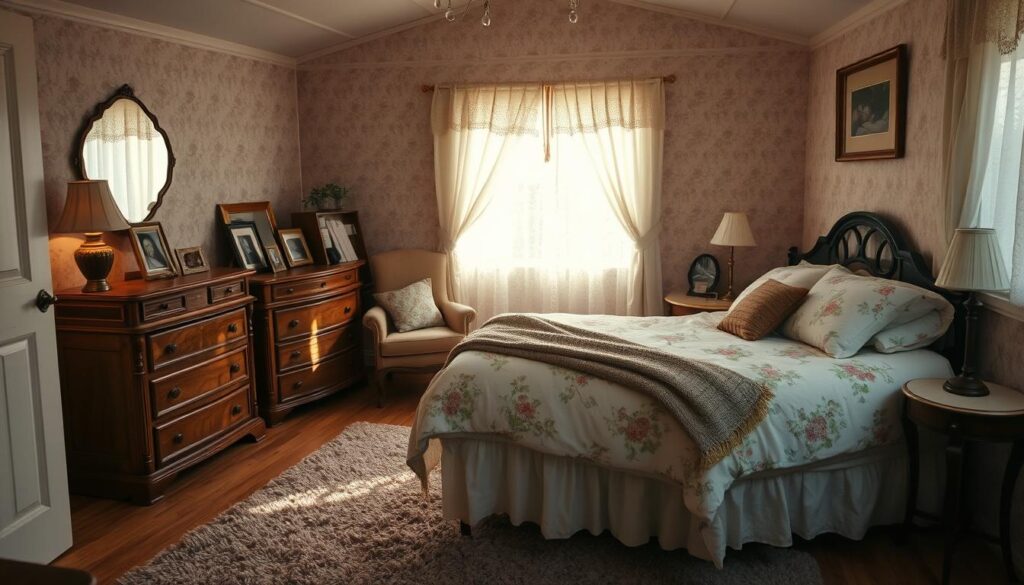
Adding Functional Decor
Decor can make a bedroom cozy. We added throw blankets, rugs, and pillows in matching colors to make the space look good and feel warm.
To keep the room tidy, we used storage like under-bed bins and a storage ottoman. This kept the room organized and added to the relaxation feel.
Functional and Stylish Bathrooms
Renovating our 1990s mobile home’s bathroom was a big task. We planned carefully to make it both useful and stylish. Our goal was to create a modern oasis.
Modern Fixtures for a Fresh Look
We started by picking modern fixtures to update the space. We chose a sleek faucet and a low-flow toilet for their look and water saving. Choosing the right fixtures can significantly impact the overall ambiance of the bathroom, making it feel more luxurious and modern.
It’s key to find fixtures that are both stylish and practical. For example, we picked a rainfall showerhead for its spa-like feel. But we also got a handheld showerhead for everyday use.
Storage Solutions for Small Spaces
Space is tight in mobile homes, and the bathroom is no exception. We installed a recessed medicine cabinet and a pedestal storage unit under the sink. Creative storage solutions are crucial in small bathrooms, keeping things tidy and organized.
- Use wall-mounted shelves or cabinets to save floor space.
- Opt for a toilet with built-in storage or use a toilet-side cabinet.
- Consider a shower caddy or corner shelves for storing shower products.
Incorporating Trends in Bathroom Design
We wanted our bathroom to look modern, so we followed the latest trends. We used large format tiles to make the space feel bigger. We also picked a bold, geometric-patterned floor tile as a focal point. Staying abreast of current design trends can inspire your renovation, making your bathroom modern yet timeless.
| Design Element | Trend | Benefit |
|---|---|---|
| Flooring | Large Format Tiles | Creates a sense of spaciousness |
| Shower Area | Rainfall Showerheads | Offers a spa-like experience |
| Storage | Recessed Medicine Cabinets | Maximizes storage without cluttering the space |
We were thrilled with our bathroom’s makeover. By focusing on modern fixtures, smart storage, and current trends, we made a bathroom that’s both functional and beautiful. It’s now a lovely retreat in our 1990s mobile home.
Embracing Outdoor Spaces: Patios and Decks
We found that a well-designed outdoor space can greatly improve our mobile home’s function and look. Renovating our 1990s mobile home, we saw patios and decks as key parts of our living area.
Enhancing Curb Appeal
First, we worked on making our outdoor space more inviting. A welcoming exterior is important for our renovation. We painted the outside, updated the front door, and added beautiful plants.
“A well-manicured lawn and a few decorative elements can make a significant difference in how inviting your mobile home looks from the outside.”
Furniture and Decoration Choices
For our patio and deck, we picked durable, weather-resistant furniture. We chose a comfy outdoor sofa set and added decorative pillows and plants for a cozy vibe.
- Select furniture that is both functional and weather-resistant.
- Add decorative elements like throw pillows and plants to enhance the ambiance.
- Consider the color scheme and ensure it complements the exterior of your mobile home.
Seasonal Maintenance Considerations
To keep our outdoor spaces in top shape, we focused on seasonal maintenance. This included regular cleaning, storing furniture in bad weather, and checking our deck and patio’s structure.
As “The Spruce” advises, regular upkeep extends your outdoor spaces’ life. It also keeps them safe and fun all year.
Choosing Sustainable Materials for Renovation
We found that using sustainable materials is good for the planet and makes our home better. When we updated our 1990s mobile home, we picked materials that are eco-friendly. This made our home healthier and more green.
Benefits of Eco-Friendly Choices
Choosing sustainable materials has many advantages. It helps the environment by using less waste and saving natural resources. Plus, these materials can make the air inside our home cleaner, which is better for our health.
Some key benefits are:
- Less carbon footprint
- Better air quality inside
- These materials last longer
Sourcing Sustainable Products
Finding eco-friendly products can be tough, but we found ways. We looked for materials with certifications like the Forest Stewardship Council (FSC) or low VOC emissions.
We also reused parts of our home, like refacing cabinets instead of replacing them. This cuts down on waste and makes our home special.
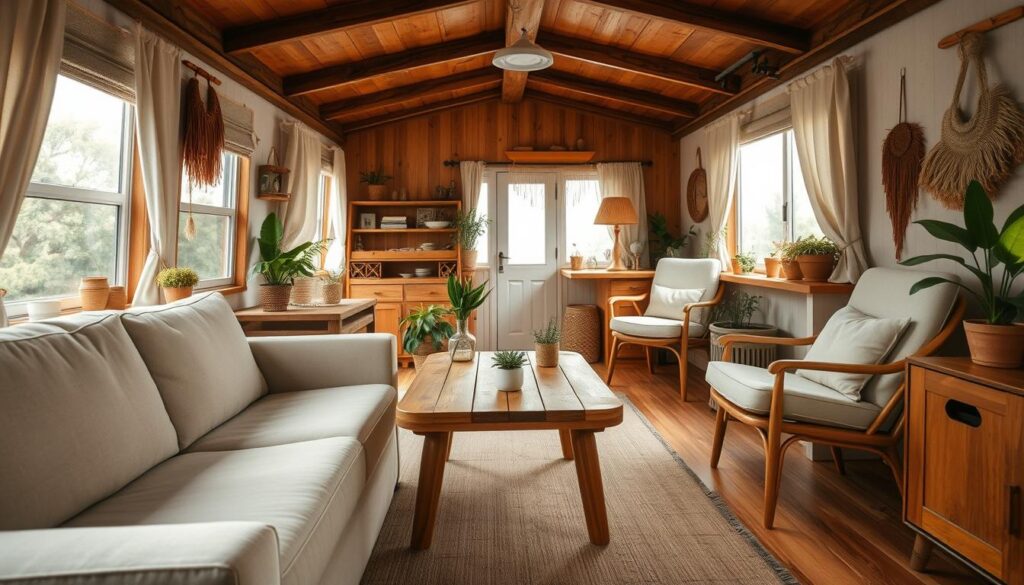
Long-Term Cost Savings
Sustainable materials might cost more upfront, but they save money in the long run. Energy-saving appliances and insulation lower our bills. And durable materials mean we don’t have to replace them as often.
| Material | Initial Cost | Long-Term Savings |
|---|---|---|
| Energy-Efficient Appliances | $1,500 | $300/year on utility bills |
| Durable Flooring | $3,000 | $500 every 5 years on maintenance |
By choosing sustainable materials, we helped the planet and made a beautiful home. Our home shows our style and our care for the environment.
Budgeting for Our Renovation
When we started our 90s mobile home remodel, budgeting was key. We knew setting a realistic budget was crucial for our mobile home interior design trends.
Setting a Realistic Budget
We began by checking our finances to see how much we could spend. We looked at our savings, loans, and extra income for the project.
It’s important to have a realistic budget to avoid financial stress. We listed all the costs, like materials, labor, and permits, to understand our financial commitment.
Prioritizing Expenses
With our budget set, we prioritized our spending. We focused on urgent areas like the kitchen and bathroom first.
This way, we made the most of our budget. We spent on the most important parts of the renovation, keeping our spending in check.
| Renovation Area | Allocated Budget | Priority Level |
|---|---|---|
| Kitchen | $10,000 | High |
| Bathroom | $8,000 | High |
| Living Room | $5,000 | Medium |
| Bedrooms | $3,000 | Low |
Cost-Effective DIY Solutions
To save money, we looked for cost-effective DIY solutions. We painted, installed flooring, and made custom furniture ourselves.
Doing things ourselves saved us money and gave us a sense of accomplishment. It’s important to know your limits and not take on too much.
Budgeting for our 90s mobile home remodel needed careful planning and creativity. By setting a realistic budget, prioritizing, and using DIY, we achieved our goals without overspending.
Documenting Our Journey: Before and After
We documented every step of our mobile home renovation. This helped us track our progress and share our experience with others. It was a way to connect with those who might be starting similar projects.
Capturing Key Moments
It was important to capture key moments during the renovation. We took photos and videos at each stage, from demo days to installing new fixtures. This visual record helped us see how far we’d come and plan the next steps.
“Documenting our journey was not just about recording our progress; it was also about preserving memories of the process,” says a seasoned renovator. Having a visual record of our journey was invaluable. It let us see the transformation unfold.
Sharing Our Progress Online
We shared our progress online through social media and a renovation blog. This helped us reach a wider audience and connect with others going through similar journeys.
By sharing our progress, we got support and encouragement from friends, family, and even strangers. Their feedback and tips were invaluable in navigating challenges.
Gathering Feedback from Friends and Family
We gathered feedback from friends and family regularly. We shared our progress with them and asked for their honest opinions. Their feedback was crucial in making decisions and adjustments.
Looking back, we see how much we accomplished. Our renovation journey taught us about patience, planning, and perseverance. It improved our living space and taught us the value of documentation and community.
Our renovation journey was transformative. It not only improved our home but also taught us valuable lessons. We’re grateful for the chance to share our story and inspire others to start their own renovation projects.
Lessons Learned from Our Renovation Experience
Renovating our 1990s mobile home was a journey full of lessons. We found that mixing old and new can make a space unique and welcoming. Our experience showed us how to add retro touches in a modern way.
Reflections on the Process
Looking back, we see things we’d do differently. We learned the value of detailed planning and budgeting to avoid unexpected costs. For future projects, we advise focusing on what’s essential and seeking expert advice when needed.
Tips for Future Projects
For those starting a mobile home renovation, think about how to use space wisely. Using eco-friendly materials and energy-saving solutions can also boost your home’s value and comfort.
Achievements and Pride
We’re proud of what we’ve accomplished. Our mobile home is now cozy and stylish. The renovation not only improved our home but also deepened our appreciation for it.

